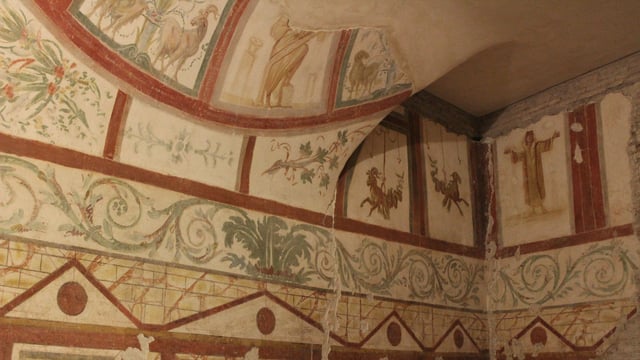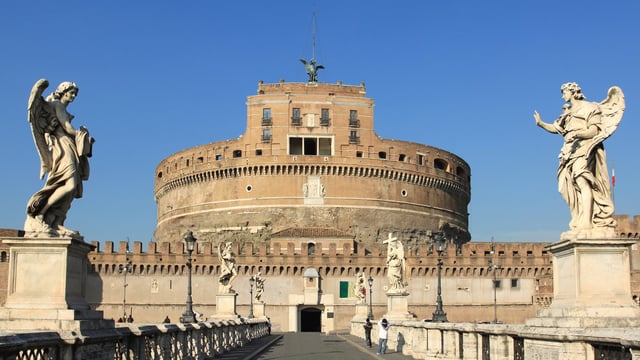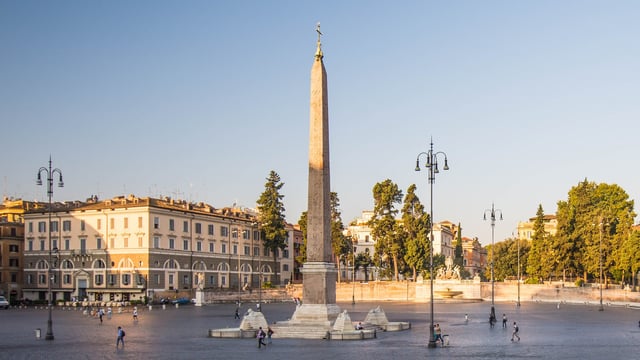Lazio
Art, Archaeology & History Sites & Museums

Rome, the Eternal City
When it comes to history in Italy, there really is no place like Rome, the Eternal City. If you are planning your first trip to Rome and looking to ease yourself into the best and most popular sights there, have a look at our suggested top ten sites to visit. Once you have visited these, there is still so much more to see. Whether you are interested in Roman sites and ruins or more recent periods, see our City Guide for Rome and the Vatican City. There is a lot of useful information for what to see and how to get tickets. As well as tips one the best walking tours of Rome, the best day-trips from Rome and much more.
Archaeology & History Sites in Lazio
Aqua Virgo
Aqua Virgo was one of the eleven aqueducts that supplied the ancient city of Rome. It was completed in 19 BC during the reign of Emperor Augustus. The aqueduct was built by Augustus’s son in law, the statesman and architect Marcus Agrippa, to supply water to the first public bath house in Rome, also built by Agrippa. During the Renaissance the aqueduct was restored to supply water to the Trevi Fountain and the fountains on Piazza del Popolo. The travertine arches that can be seen at this locale marks one of a few spots where remains of the Roman aqueduct can be seen.

Arch of Janus
This massive, four-way arch built of marble is 16 metres high and 12 metres square. The north-west pier has a staircase that would have led to a series of rooms and chambers at the top. The enigmatic structure is built over an ancient drain that ran down the valley to the Tiber River. And is thought to have been a boundary marker rather than a triumphal arch. Also, dating the arch has not been simple. Remains of terracotta storage jars were found to have been used in the concrete vault, which are typical of jars used in the 4th century AD.


Baths of Caracalla
Built under Emperor Caracalla between 211 and 216 AD, these baths were the second of larger Imperial bath houses in Rome. And the sheer size of the baths still captivates visitors today. The bathhouse covered an area of 100,000 metres square and accommodated about 10,000 people. More of a leisure centre than a series of baths, these were the second to have a public library. The baths continued to be used until the 6th century. Now a popular archaeological attraction, the ruins are the summer home of the Rome Opera Company.

Capuchin Crypt
Rome’s Capuchin Crypt – officially the Museum and Crypt of the Capuchin Friars – is at once both shocking and fascinating. In a series of small interconnected chapels beneath the church of Santa Maria della Concezione dei Cappuccini are the bones and mummified remains of an estimated 4,000 friars who died between 1528 and 1870. Far from being a macabre spectacle, the Capuchin order believes the remains of former friars are a silent and poignant reminder of humanity’s mortality and the passage of life on Earth.


Case Romane del Celio
At the top of the Caelian Hill are the Case Romane del Celio, snapshots of early Roman history.Twenty rooms are preserved under a 4th century basilica, each with evidence for their former use over the years as homes, shops and even as a Christian shrine. Decorated with a unique mix of pagan and early Christian frescoes, these rooms give visitors a glimpse into ancient Roman homes and daily life, showing the changes that time and the rise of Christianity brought to the city.


Castel Sant'Angelo - Hadrian's Mausoleum
Castel Sant’Angelo is one of the most important historical sites in Rome. Now a museum, the structure was first built on an artificial mound on the northern banks of the Tiber River. It was built as a mausoleum for Emperor Hadrian and is wife Sabrina. In the early medieval period it was converted into a military fortress. Given its proximity to St Peter’s Basilica, in the 14th century it was converted into a residence for the Popes. The Vatican also used it as a prison. All of this history is on display to visitors , including the Papal chambers and their exquisite frescoes.


Circus Maximus
The site of the Circus Maximus is said to be the city’s oldest and largest public space. Evidence suggests it was founded sometime during the 6th century BC. By the end of the 1st century AD, it could accommodate an audience of over 250,000 people. Besides chariot races, other public spectacles including executions, gladiatorial contests and animal hunts were also staged here. The rounded, eastern end has recently been restored, and during summer months visitors cane experience the circus through an augmented reality experience.

Flaminio Obelisk
At the centre of Piazza del Popolo stands one of the first Egyptian obelisks brought to Rome by Augustus to mark the 20th anniversary of his conquest of Egypt in 10 BC. Made of Aswan granite, the obelisk was made for Seti I before 1300 BC, but only three sides bear his inscriptions. Ramses II had the fourth side inscribed. In Rome the Flaminio obelisk was erected at the eastern end of the spina at the Circus Maximus. During excavations in 1587 the obelisk was found and then moved to the Piazza del Popolo under instruction from Pope Sixtus V. The Egyptian style lions and basins were added in 1823 by the Italian architect Guiseppe Valadier.

Hadrian's Villa
Built for the Roman Emperor Hadrian at the beginning of the second century AD, Villa Adriana in Tivoli is said by many to be the most remarkable of all the country retreats built during the Roman era. The architecture is indicative of how well travelled Hadrian was, bringing together architectural features and sculptural elements from across the Mediterranean world. As the Emperor’s villa this was no ordinary country retreat, rather it was a small city built to accommodate the rulers staff, courtiers, guards and slaves. A trip to the town of Tivoli, where both Villa Adriana and Villa d’Este are located, is a popular and easy day trip from Rome.

Ludus Magnus
Adjacent to the Colosseum, and beneath street level, are the remains of the Ludus Magnus – what was the barracks and training arena for the gladiators that fought in the iconic Roman amphitheatre. The ruins were discovered in 1937 during building works, but only excavated at the end of the 1950s. The rest of the arena and what is thought to have been the armoury are still under the adjacent streets and buildings. The entire block has been left exposed and visitors can see just under half of the arena surrounded by barracks which housed the gladiators. When the Colosseum ceased to function this area was used for burials.

Museums & Art Galleries in Lazio
Capitoline Museums
The Capitoline Museums have a long history, and are said to be the oldest public collection of archaeological artefacts in the World. They are certainly amongst the finest museums in Rome. The origins of the collections date back to 1471 when Pope Sixtus IV had 6 bronze Roman statues moved to the City Council on the Capitoline Hill. Now, many centuries later, there are over 1300 objects, most of which are from archaeological sites in Rome itself. The Capitoline Museums are in fact three different buildings, called palazzos, that surround the trapezoidal Piazza del Campidoglio

National Archaeological Museum of Tarquinia
Built in the early 15th century for a Cardinal, the Palazzo Vitelleschi has housed the collections of the Museo Archeologico Nazionale Tarquiniense since 1924. The primary focus of the exhibitions here are the Etruscans, with displays based on artefacts recovered from the Necropolis of Monterozzi, just to the east of the town of Tarquinia. Objects on display range from sarcophagi made of marble from the Greek island of Paros, and other votive offerings, local and foreign ceramic vessels. The highlight of the museum are the reconstructed funerary destroyed in the 1950s and 1960s. The reconstruction includes 5th century BC paintings by a Greek artist.

National Archaeology Museum of Cerveteri
Opened in 1967, the museum is housed in the 13th century castle. On display, set out in chronological order, are the artefacts found in archaeological sites in the area, ranging from the 9th century BC to the time of the Romans. Of particular importance are the many funerary objects such as sarcophagi and memorial stones recovered from the Etruscan cemeteries near the town, including the Necropolis of Banditaccia. The museum also has an impressive collection of local and imported ceramics, excavated from urban and domestic areas of nearby archaeological sites. In 2015 the Krater and Kylix of Euphronios were returned to the Italy, stolen objects that were recovered from American museums.

Vatican Museums
Founded in the early 16th century by Pope Julius II, the pubic museum of the Vatican City holds the vast collection of the Catholic Church. Of the estimated 70,000 only 20,000 are on public display. These include some of the most well known examples of Etruscan art, Roman sculpture and Renaissance masterpieces. One of the most well known sculptures is the Roman Laocoön and His Sons, the acquisition of which in 1506 is said to have been the origins of the Vatican Museums. The route through the museums include Michelangelo’s ceiling in the Sistine Chapel and the Raphael Rooms of the Apostolic Palace. The museum also has an important collection of Egyptian antiquities.

















